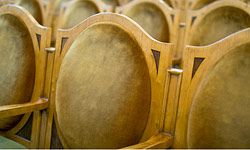When it comes to choosing a fabric for your upholstery project, the options are virtually endless. Make sure your textile is of upholstery grade-tougher and heavier than drapery or fashion varieties-and then let your imagination run wild.
Tip: If a salesperson can't assist you, you can perform a basic test on your fabric swatch to ensure it is of upholstery grade. Hold the swatch from two corners (diagonally opposite each other) and pull gently. Then switch your hands and pull from the other two corners. If the fabric maintains its basic shape, it's suitable for upholstery purposes.
Consider swatches in bold colors, vibrant patterns and interesting textures. Try colors like burnt orange, deep plum and Kelly green that will pop against wood and add a splash of color to an otherwise neutral space. Textures like satin, velvet and suede create warmth and depth, while oversized prints play with scale and proportion for added interest.
As you're combing through options, remember that many different textiles can be applied in upholstery form. Bring instant texture and depth with unexpected choices like embroidery, crewel work, cross-stitch, cotton rugs, wool rugs, batiks and tweeds.
- Measure twice, cut once: When upholstering any furniture seat, the piece of fabric must be large enough to fully cover the top and wrap over the sides. At the fabric store, cut your fabric with an extra allowance to ensure the fabric can be securely fastened to the bottom of the seat.Tip: There's no reason you can't remove your cushion from the furniture and bring it with you to the fabric store. It's a simple way to guarantee a fool-proof purchase.
- Something special: Upholstering a seat doesn't require a large amount of fabric, meaning you can splurge and purchase an "occasional" fabric. Occasional fabrics feature more luxurious designs, dyes and thread counts than typical fabrics. So go ahead, choose something you wouldn't normally consider and pump up the wow factor in your home.
